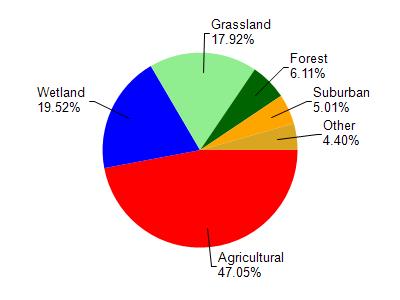Manitowoc
No
No
No
Fish and Aquatic Life
Overview
An impoundment of the Manitowoc River, this waterbody covers 43 surface acres and is 6 feet deep.
The shoreline totals 2.47 miles, of which .01 miles are publicly owned. A 411 square mile watershed drains into this impoundment. There are no adjoining wetlands. Partially wooded areas and lawns are steeply sloped towards the pond. Abundant algae blooms severely reduce water clarity. Northern pike and largemouth bass are present, while panfish are abundant.
Date 2002
Author Aquatic Biologist
Historical Description
Source: 1968, Surface Water Resources of Manitowoc County Clark Mills Pond, T19N, R22E, Sections 21, 28 Surface acres - 43, S.D.F. = 2.69, Maximum depth = 6 feet.
An impoundment of the Manitowoc River at the east end of the former glacial Lake Manitowoc. The dam is 8 feet high. The brown- stained water has a low transparency and is alkaline in nature. The pond is managed for northern pike, largemouth bass, and panfish species including bluegills and black crappies. A large rough fish population is the major problem. A town road provides access with parking. Waterfowl make limited use of the flowage and hunting is permitted. There are no adjoining wetlands.
Date 1968
Author Surface Water Inventory Of Wisconsin
Condition
Wisconsin has over 84,000 miles of streams, 15,000 lakes and milllions of acres of wetlands. Assessing the condition of this vast amount of water is challenging. The state's water monitoring program uses a media-based, cross-program approach to analyze water condition. An updated monitoring strategy (2015-2020) is now available. Compliance with Clean Water Act fishable, swimmable standards are located in the Executive Summary of Water Condition in 2018. See also the 'monitoring and projects' tab.
Reports
Management Goals
Wisconsin's Water Quality Standards provide qualitative and quantitative goals for waters that are protective of Fishable, Swimmable conditions [Learn more]. Waters that do not meet water quality standards are considered impaired and restoration actions are planned and carried out until the water is once again fishable and swimmable
Management goals can include creation or implementation of a Total Maximum Daily Load analysis, a Nine Key Element Plan, or other restoration work, education and outreach and more. If specific recommendations exist for this water, they will be displayed below online.
Monitoring
Monitoring the condition of a river, stream, or lake includes gathering physical, chemical, biological, and habitat data. Comprehensive studies often gather all these parameters in great detail, while lighter assessment events will involve sampling physical, chemical and biological data such as macroinvertebrates. Aquatic macroinvertebrates and fish communities integrate watershed or catchment condition, providing great insight into overall ecosystem health. Chemical and habitat parameters tell researchers more about human induced problems including contaminated runoff, point source dischargers, or habitat issues that foster or limit the potential of aquatic communities to thrive in a given area. Wisconsin's Water Monitoring Strategy was recenty updated.
Grants and Management Projects
Monitoring Projects
| WBIC | Official Waterbody Name | Station ID | Station Name | Earliest Fieldwork Date | Latest Fieldwork Date | View Station | View Data |
|---|
| 73100 | Clarks Mills Pond | 100468 | Clarks Mills Pond | 6/19/1992 | 8/30/2017 | Map | Data |
| 73100 | Clarks Mills Pond | 10019748 | Manitowoc River - Clarks Mills Pond -- Ramp | | | Map | Data |
| 73100 | Clarks Mills Pond | 10019659 | Clarks Mills Pond -- Access at Cth J And Pieschel Rd (Manitowoc Co) | | | Map | Data |
|

Watershed Characteristics
Clarks Mills Pond is located in the Lower Manitowoc River watershed which is 168.33 mi². Land use in the watershed is primarily agricultural (47%), wetland (19.50%) and a mix of grassland (17.90%) and other uses (15.50%). This watershed has 264.70 stream miles, 2,910.36 lake acres and 19,995.06 wetland acres.
Nonpoint Source Characteristics
This watershed is ranked High for runoff impacts on streams, Not Ranked for runoff impacts on lakes and High for runoff impacts on groundwater and therefore has an overall rank of High. This value can be used in ranking the watershed or individual waterbodies for grant funding under state and county programs.However, all waters are affected by diffuse pollutant sources regardless of initial water quality. Applications for specific runoff projects under state or county grant programs may be pursued. For more information, go to surface water program grants.